

Marlin’s first production repeating lever action rifle was the Model 1881; tubular magazine fed, top ejecting and chambered for the .45-70 and .40-60. The Model 336 came along in 1948 and remains a popular design, showcasing Marlin’s most distinguishing features.
The Model 336 is a closed top receiver, round breech bolt design. This approach provides full support of the breech bolt, allows side ejection and a incorporates a very large vertical locking bolt that holds the breech bolt in battery when the lever is closed. The rifle on the right, a late 1956 version is listed as having a 7 shot capacity, The 2014 version on the left is listed as holding 6 rounds.
Originally chambered for the 30-30 Winchester and .32 Special, in 1953, the .35 Remington chamber was added.
In 1956, the Model 336 left the factory drilled and tapped for scope mounts and with Micro-Groove type rifling in place of Ballard.
In 1959, the Marlin was given a gold plated trigger and the top and bottom receivers were sand blasted to a matte finish.
In 1962, Marlin began to phase out the 32 Special chamber from the Model 336 product line and by 1964 it was dropped completely.
In 1982 the gold trigger went away and in 1984 the rifle received a cross bolt safety. Two dates that lie in infamy for Marlin fans. Oh, grow up, the gold colored trigger is back.
While there have been many running changes throughout the years, some things have remained constant. The Marlin utilizes a lot of forged parts, including: receivers, trigger plates, hammers, levers, carriers, and locking bolts.
The Model 336C was priced at $61 in 1949. My 1956 vintage gun was priced at $73. By 1988, they were retailing for $326. Today the MSRP is $610 which coincidentally reflects no more than the U.S. rate of inflation.
The Marlin Model 336C – old versus new
When I see folks going on about the current Marlin made by Remington versus the Marlin made by the Marlin company, there is almost always the owner of an old gun spearheading the controversy. I know how that goes, I own one and it is tough to set aside good memories and nostalgia when things change, even if objectively for the better. The new gun is tighter, more accurate, more nicely finished, and arguably better looking. My old Marlin was my first centerfire rifle, given to me by my father on Christmas, the week following my twelfth birthday. That old gun was with me in the Black Hills of South Dakota forty-five years ago when I knelt in the snow to gut out a buck; heat and steam rising from its entrails in the sub zero weather and the strong scent of pine needles in the air.
The new Marlin is manufactured by a very substantial company, with two hundred years of firearm manufacturing experience and a firm grasp of modern materials and manufacturing technology. The old Marlin was with me the first time my wife and I took our eldest son, then twelve years old, boar hunting. We brought home a freezer full of pigs and a kid with a lot of new things to think about. However, leave out the emotional components of memories and a deep sense of nostalgia, I would buy the new Marlin Model 336, take advantage of its improvements over the old, and go out and make some new memories. So let’s move on and look at the current, very traditional, Marlin Model 336.
Sight refinements and good traditions
The current Model 336’s semi-buckhorn rear sight, like the original, is drift adjustable for windage. Unlike the original, the rear sight can fold forward and out of the way for scope use. Additionally, the elevation slide is wider for better support and serrated at the end for greater finger contact.
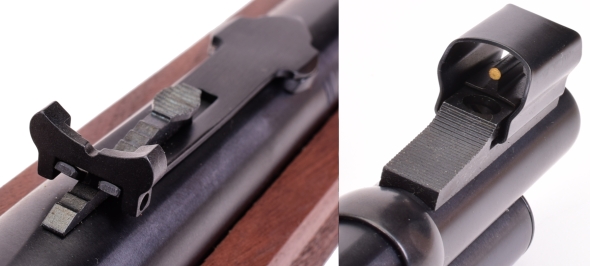
The front sight has a brass bead sort of like the earlier gun, as well as a hood, however, the early production had a gold bead from sight and the hood on the new model is a “Wide-Scan” type for a better sight picture and faster tracking. The new Marlin, like the early model, is drilled and tapped for scope and peep sight mounting and it is supplied with an ambidextrous offset thumb spur that gets the hammer out from under a scope. Hammer spur not in place below… use your imagination.
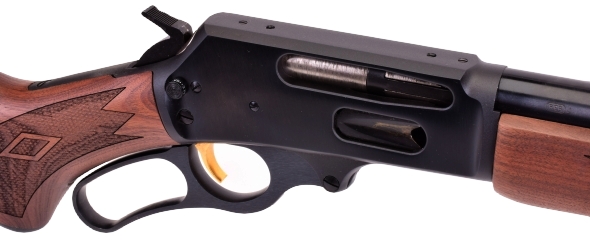
The current Marlin 336 retains those little appearance features of the earlier guns; brass bead front sight, Marlin trademark “Bullseye” near the buttstock sling swivel and the gold trigger. Plus the top and bottom of the receiver are bead blasted to cut down on glare like earlier production.

The current forearm is considerably wider than they were in early production; 1.68″ compared to 1.34″. I like the more slender stock aesthetics, but the new production is comfortable in hold. However, I am concerned that the new version won’t fit in the saddle scabbard I keep on my horse… neither of which I actually use, ride or own. Confusing isn’t it? Sounded better in my head before I wrote it.
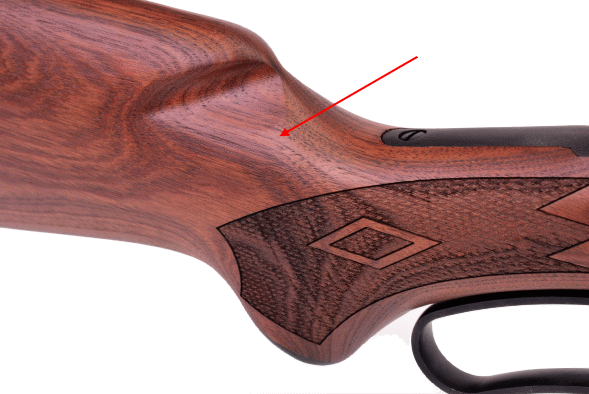
Current Marlin Model 336 product is made a bit thicker at the grip and wrist than my old gun and my old gun does not have a red arrow. The early gun measures 1.15″ at the arrow, the new production measures 1.45″. Coincidentally, the 1.45″ is the same as the Model 1895 guide gun at the same locations, but more than likely a function of modernized style and manufacturing process simplification. Again, better feel and hold when shooting, not as slender as the early gun.
Earlier Marlins utilized quarter sawn buttstock with straight horizontal grain. Current production buttstocks are made from flat sawn blanks, both versions are made from American Black Walnut. I can appreciate the strength and utility of the early stock, but I certainly don’t mind the more obvious, flowing grain of the current stock. They look as good or better than the stocks put on new generation $1,200 Winchester lever guns.
I don’t know why people get tangled up in their shorts over crossbolt safeties, especially when they are hammer blocking and only protrude as little as necessary. In addition to the cross bolt safety, there is the half cocked hammer position and, just like the original, there is a two piece firing pin that will not line up to fire unless the lever is completely closed.
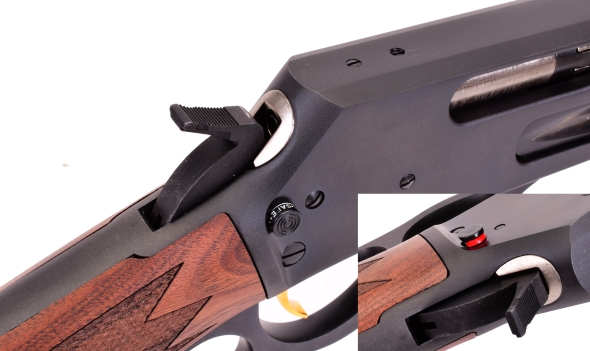
The only accidental discharge of a firearm I ever experienced was when I was a kid, hunting black bear is upstate New York. I was posting a hill side, sitting on a stump, in an area where I had earlier seen a bear. A round was in the chamber, the rifle was laying across my knees and I attempted to lower the hammer to half cock. I heard a gun shot that sounded very near by, so close it made my own gun jump. Fortunately, the rifle was pointing in a safe direction and no one was around. I still find that memory embarrassing and I learned a lesson I never forgot. So, yeah, the safety works for me.
|
Marlin Model 336C |
|
| Origin | Ilion, NY |
| Manufacturer | Remington |
| Model | Model 336C |
| Type | Lever Action |
| Caliber | 30-30 WCF |
| Capacity | 6+1 |
| Barrel Length | 20.00″ |
| Micro-Groove Rifling | 1:10″ |
| Nominal Weight | 7.0 lbs |
| Overall Length | 38.5″ |
| Stock | Walnut |
| Hardware | Blued Steel |
| Length of Pull | 13.25″ |
| Drop at comb | 1.25″ |
| Drop at heel | 2.00″ |
| Sights | Metallic |
| Scope | Drilled and Tapped |
| Trigger Pull | 5 lbs. 11 oz. |
| Safety | Cross Bolt Safety |
| MSRP | $610 |
The myth of the 100 yard 30-30 WCF
Please don’t make me recite the stats for the 30-30 WCF, its history and game killing record. The need to defend the history of such a successful cartridge makes my nose bleed. Modern times and technology have been kind to this cartridge. A Hornady 160 LeverEvolution round can smack a deer at 300 yards with 1700 fps of retained muzzle velocity and 1025 ft-lbs of energy, never rising more than 3″ or falling more than 12″. It remains a deer and black bear slayer.

There are approximately 36 factory loads that are readily available, originating with 13 manufacturers. Bullet weights, a combination of jacketed and cast, range from 125 to 190 grains. If that is not enough of a selection, there are many types of bullets and powder combinations that work well for the handloader. Above, from left to right, 150 grain Federal Fusion, 170 grain Remington Core-Lokt, 160 grain Hornady LeverEvolution, vintage Remington 150 grain Core-Lokt hollow point, 170 grain Oregon handload, and a 170 grain Sierra handload.
The 30-30 WCF is an excellent deer, black bear and Hog cartridge. It can easily and effectively, be loaded for varmint control, small to large. I’ve hunted with the round extensively in both rifle and handgun applications and I’ve never had anything walk away from a hit.
Marlin 336C live fire
Five types of 30-30 WCF factory ammo types that are commonly selected for hunting deer, black bear and hogs were used for the live fire portion of the evaluation. The recorded velocity over two chronographs was higher than all but one factory rating. Forgive the cliché, but it is, what it is.
| Brand of Ammunition | Bullet Type |
Weight Grains |
Chrono Reading |
Mfg. rated |
| Winchester X | Soft Point | 150 | 2435 | 2390 |
| PMC | Soft Point | 150 | 2443 | 2159 |
| Fusion | Soft Point | 150 | 2513 | 2390 |
| Hornady LeverEvolution | Poly Tip | 160 | 2449 | 2400 |
| Remington Core-Lokt | Soft Nose | 170 | 2173 | 2200 |
Part of the reason for the relatively high velocity could be the Marlin’s Micro-Groove rifling. With lands beveled where they intersect grooves and at 0.002″ high about half the restriction of Ballard rifling, bore friction could be substantially less. It has also become common place for Federal Fusion to outperform Hornady’s LeverEvolution and Superformance ammunition for some cartridges.
I only zero for one cartridge type from all types utilized, and then let bullet weight and velocity changes determine point of impact as determining group size potential and not bullseyes are the objective. The targets that follow are pretty much the story on the Marlin Model 336 and decent factory ammunition. On the left is a 50 yard 150 grain Federal Fusion 3 shot group, shot at that distance out of deference for the accuracy standard set by my old Marlin 336. It measures barely 0.4″. So I pushed the target out another 50 yards and shot the Remington 170 grain Core-Lokt 3 shot group on the right. That one measures slightly more than 1.0″.
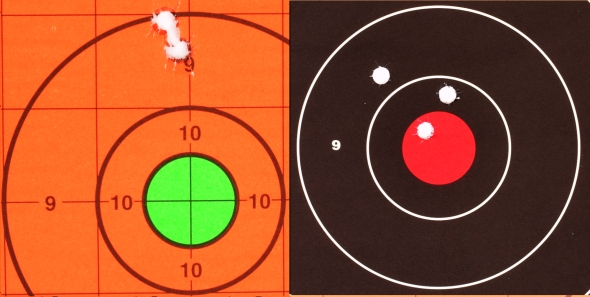
Shot from a sled using a scope I probably wouldn’t carry in the field, but appropriate for qualifying mechanical accuracy, the Marlin 336 delivers about the same as my recently manufactured Model 1895 in 45-70… just smaller bullet holes and less recoil. The ammo noted delivered the best accuracy. The least accurate was PMC at 1.4″ and some of my quickly loaded and not developed cast bullet handloads at 1.7″. The rest hovered right around the 1″ mark.
Have to stop sometime…
The current Marlin Model 336C is more of a gun than my old keepsake. My vintage Marlin is a beautiful old rifle with great sentimental value, but it can’t keep up with the newest version in terms of accuracy, quality of materials and workmanship and probably not in good looks. Still, my old Marlin won’t be retired and I think it makes up for good looks with developed character.
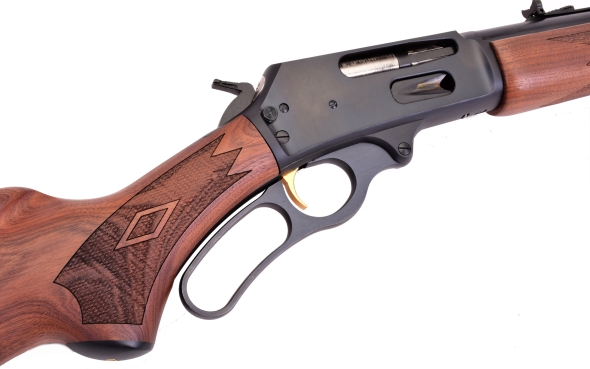
The thing is, everyone doesn’t have an old Marlin Model 336 tucked away and buying an old rifle does not buy its history and the experience with its original owner. So it seems, for anyone who wants to have a terrific deer rifle, and who wants to start building their own stories for the future, the new Marlin is a good place to begin. In fact, the current Marlin 336 is a valuable gift to give to a new hunter to start them on their way. But then you don’t have to take my word for it. Stop by a local gun shop, hold one in your own hands, look through the sights and crank the lever. You’ll know exactly what I mean.

Email Notification